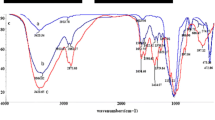Abstract
A model of vascular endothelial cell membrane chromatography was established by using an ECV304 cell membrane stationary phase (ECV304 CMSP) prepared by immobilizing the ECV304 cell membrane onto the surface of silica carrier. The surface and chromatographic characteristics of ECV304 CMSP were studied. The active component from Caulophyllum robustum was screened by using the model of vascular endothelial cell membrane chromatography. The interaction between the active component and membrane receptor was determined by using a replace experiments. The effect of the active component was tested by using tube formation of ECV304 cell. The results indicated that the model of ECV304 cell membrane chromatograph (ECV304 CMC) can stimulate the interaction between drug and receptor in vitro and the retention characteristics of taspine as active component was similar to that of model molecule in the model of ECV304 CMC. And therefore, taspine acted on VEGFR2 and inhibited the tube formation of ECV304 cell induced by VEGF. This model can be used to screen definite active component as a screening model.
Similar content being viewed by others
References
He L C, Geng X D. Cell membrane chromatography-new method of the interactions between drug and receptor. New Progr Biomed Chromatogr, 1996, 3: 8–9
He L C, Yang G D, Geng X D. Enzymatic activity and chromatographic characteristics of the cell membrane immobilized on silica surface. Chin Sci Bull, 1999, 44(9): 826–831
He L C, Wang S C, Geng X D. Coating and fusing cell membrane onto a silica surface and their chromatographic characteristics. Chromatographia, 2001, 54: 71–76
Zhang D, Yuan B X, Deng X L, et al. Chromatography studies on bio-affinity of nine ligands of α1-adrenoceptor to α1D subtypes over-expressed in cell membrane. Sci China Ser C-Life Sci, 2004, 47(4): 376–381
Hou J, Yuan B X, He L C, et al. Evaluation of drug-muscarinic receptor affinities by using cell membrane chromatography. Chin J Pharmacol Toxicol, 2003, 17: 70–73
Wang Y, Yuan B X, Deng X L, et al. The preparation of HEK293 1A or 1B cell membrane stationary phase and the chromatography affinity study of ligands of α1-adrenoceptor. Anal Biochem, 2005, 339: 198–205
Yuan B X, Hou J, He L C, et al. Evaluation of drug-muscarinic receptor affinities using cell membrane chromatography and radioligand binding assay in guinea pig jejunum membrane. Acta Pharmacol Sin, 2005, 26: 113–116
Liang M J, He L C, Yang G D. Screening, analysis and in vitro vasodilatation of effective components from Ligusticum Chuanxiong. Life Sci, 2005, 78: 128–133
Carmeliet P, Jain R K. Angiogenesis in cancer and other diseases. Nature, 2000, 407: 249–257
Folkman J. Angiogenesis and apoptosis. Semin Cancer Biol, 2003, 13: 159–167
Arbiser J L. Regulation of angiogenesis and tumorigenesis. Semin Cancer Biol, 2004, 14: 79–80
Folkman J. Angiogenesis in cancer, vascular, rheumatoid and other disease. Nat Med, 1995, 1: 27–31
Sandra L, Erik D C, Johan N. Angiogenesis: Regulators and clinical applications. Biochem Phar, 2001, 61: 253–262
Ziegler B L, Valtieri M, Porada G A, et al. KDR receptor: A key marker defining haemopoietic stem cells. Science, 1999, 285: 1553–1558
Veikkola T, Karkkainen M, Claesson-Welsh L, et al. Regulation of angiogenesis via vascular endothelial growth factor receptors. Cancer Res, 2000, 60: 203–212
Prewett M, Huber J, Li Y, et al. Antivascular endothelial growth factor receptor monoclonal antibody inhibits tumor angiogenesis and growth of several mouse and human tumors. Cancer Res, 1999, 59: 5207–5218
Miura S, Emoto M, Matsuo Y, et al. Carcinosarcoma-induced endothelial cells tube formation through KDR/Flk-1 is blocked by TNP-470. Cancer Letts, 2004, 203: 45–50
Haspel H C, Sciclli G M, Mcmahom G, et al. Inhibition of vascular endothelial growth factor-associated tyrosine kinase activity with SU5416 blocks sprouting in the microvascular endothelial cell spheroid model of angiogenesis. Microvascular Res, 2002, 63: 304–315
Shim D H, Hee Y K. Protein kinase B inhibits apoptosis induced by actinomycin D in ECV304 cells through phosphorylation of caspase 8. Arch Biochem Biophys, 2004, 21: 214–220
Liang G B, Zhang G P, Jin H M. Influence of basic fibroblast growth factor on ECV304 cell migration. Chin J Pathophysiol, 2005, 21: 16–20
Zhang J T. Modern Experimental Methods in Pharmacology (in Chinese). Beijing: Beijing Medical University and Beijing Xiehe Medical University Unite Press, 1998. 999–1015
Lowry O H, Rosebrough N J, Farr A L, et al. Protein measurement with the Folin phenol reagent. J Bio Chem, 1951, 193: 265–276
Li Y P, He L C. Inhibitory effects of the alkaloids from Radix Caulophylli on the proliferation of human vascular endothelial cell. Acad J Xi’an Jiao Tong Univ, 2005, 17: 185–187
Perdue G P, Blomster R N, Blake D A, et al. South american plants II. Taspine isolation and anti-inflammatory activity. J Pham Sci, 1979, 6: 124–127
Itokawa H, Ichihara Y. A cytotoxic substance from Sangre de Grado. Chem Pharm Bull (Tokyo), 1991, 39: 1041–1042
Bertucci C, Bartolini M, Gotti R, et al. Drug affinity to immobilized target bio-polymers by high-performance liquid chromatography and capillary electrophoresis. J Chromatogr B, 2003, 797: 111–129
Tong Y G, Zhang X W, Zhao W M, et al. Anti-angiogenic effects of Shiraiachrome A, a compound isolated from a Chinese folk medicine used to treat rheumatoid arthritis. Euro J Pharm, 2004, 494: 101–109
Prewett M, Huber J, Li Y, et al. Antivascular endothelial growth factor receptor (flk-1) monoclonal antibody inhibits tumor angiogenesis and growth of several mouse and human tumors. Cancer Res, 1999, 59: 5209–5218
Author information
Authors and Affiliations
Corresponding author
About this article
Cite this article
Li, Y., He, L. Establishment of the model of vascular endothelial cell membrane chromatography and its preliminary application. CHINESE SCI BULL 52, 922–928 (2007). https://doi.org/10.1007/s11434-007-0149-5
Received:
Accepted:
Issue Date:
DOI: https://doi.org/10.1007/s11434-007-0149-5




